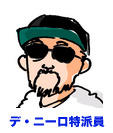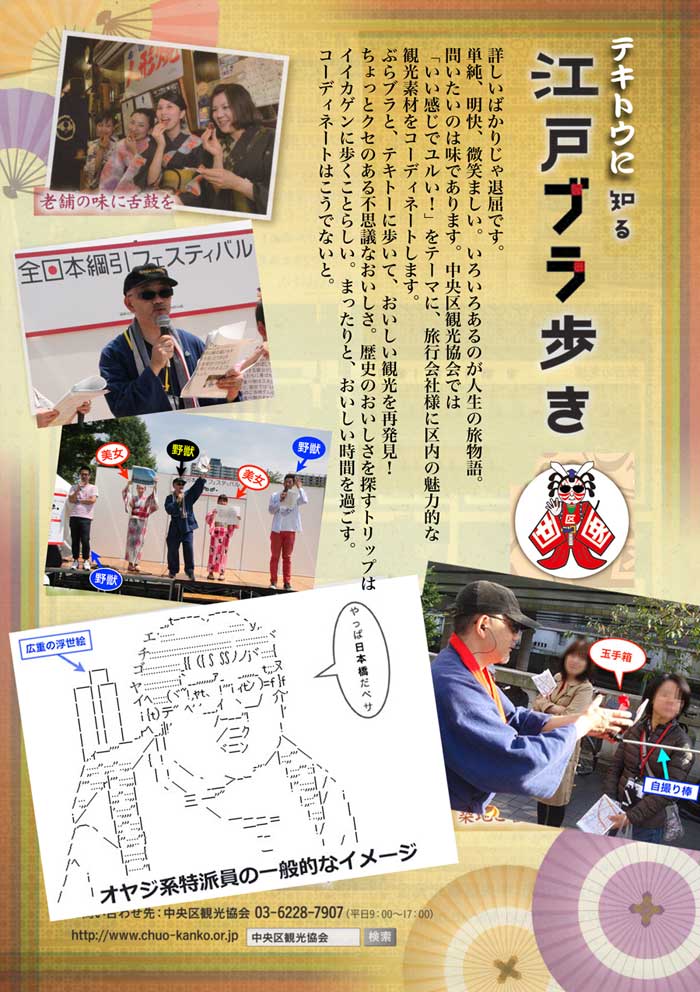
I participated in the “Challenge & Skill Up Training” sponsored by the Chuo-ku Tourism Association.
In order to foster local tourism navigators who can flexibly respond to the diversifying levels and types of customers that have been increasing in recent years, correspondents simulate everything from tour planning to course guidance, and observe, analyze, and evaluate the pattern with outside experts. Even when guiding you to the same sightseeing spot or historic site, it may be difficult for couples in their 20s and couples in their 60s to judge whether to change their customer service. That's why it's okay to make tea turbid with an average approach for the 40s ...
There is also a variation in the awareness of the purpose of participating in the subdivided town walk, and the ability to respond to changes in social conditions and generational values, the content of the gaiding and the reaction on site are strictly checked. After the tour, experts said, "I can't get guidance there," or "I'm not studying enough," "I'm too fast," "I'm long," "Oyajigag is boring," "Old information," etc. It's about to break my heart when I'm told about Kudokudo, Nechinechi, and fizzy (>_<).
Unfortunately, it wasn't such a terrible training. Guides your favorite courses as you like, only the good points are evaluated, and the bad points are "teach me gently." Thank you very much to everyone involved.
A taxi wasn't particularly good at Ginza (I prefer Shimbashi, but it's Minato-ku), but the starting point was in front of the Dentsu Building in Ginza, so in the surrounding area, Shiseido, the commercial law training center ruins (the birthplace of Hitotsubashi University), Takuboku Ishikawa poetry monument, and Kinshinoyashiki. But I thought about it. Is this interesting?
What is it while planning yourself, but it is a course that you never want to apply.
What do you mean and appeal to SoftBank's artificial intelligence robot, Pepper, who can do it?
Maniac tourists who download the map application and GPS sightseeing information software to their smartphones and come, while this is giving historical guidance, I was gaged in front of me and said, "There seems to be a different view in that respect. "
A guide is a world where customers can enjoy, whether it is a volunteer or a professional. I've always been searching for what kind of wonderful gaiding that can keep my heart in no matter what kind of customer you are.
I want to impress myself if I can't do it. With such a luxurious ambition, I was thinking about what I needed to make it happen.
Last year, I observed various guides at fixed-point observation in Chuo-ku and referred to the activities of correspondents, but all guides are studying well and talking well. Good, preparation is all complete, motivation is manman. Occasionally, I was doing it safely while giving out individuality.
However, I feel like something is missing.
That "something" is probably communication, but there are too many information, stories, and contents that the guide wants to convey before that.
I'm sorry! That's what I mean
I thought it might be the root cause.
In order to guide you, you have to study a huge amount, including value-added information. I think "guiding" is synonymous with "studying". However, I don't pack anything and provide tourist information like a university lecture. It's really the same as the lectures at the University of Tumalanai, and it's not interesting. Lecture content, teaching materials, themes and items have already become rutted with a long history.
I can't help but do it in the same way as everyone else. "Gaiding" is devised. Isn't it the highlight of the Human Guide to create a creative presentation with imagination that Pepper can't imitate? Whether it's old or new, above all, the key is to share what you feel, what you're impressed, and what you're particular about with your customers. First of all, it would be great if you value what you can enjoy yourself, and as a result, you can enjoy it.
By doing so, I think that a creative guide full of originality will be realized.
To do so, reduce the amount of content and make it simple. If you have too much ingredients, you will get indigestion. I think it is necessary to have a sense of balance and filthy to make it appropriate without thinking deeply.

↑ The Chuo-ku Tourism Association's "Edo Town Walking" brochure is processed into a De Niro version. We do not distribute it.
Even if you use the same ingredients, it is the chef's skill and personality that dishes with different tastes come out. The aptitude of a guide may be similar to that of a cook.
The ideal thing about an atakushi is delicious sightseeing.
It's just sweet, bored.
It's spicy, bitter, sibling.
There are many things to do.
What I want to ask is the taste.
A sightseeing where you can relax your body and mind.
A deep taste that can be seen by chewing well.
A mysterious taste with a little habit.
I hate having no taste. It's not bad.
A trip that tastes the taste of history and culture seems to be searching for his own "travel story".
Meet a delicious person, read a delicious book, and
Find delicious information and get to know Tekito.
Oh~! As I noticed this time, the atakushi couldn't cook (>_<).
Nevertheless, you should be able to do some kind of heartfelt "Omote-te-na-shi" with the textured side dishes and drinks purchased at convenience stores.
In 2016, the atakushi with customers was going to become a more savory boy.
(>_<)
I'm sorry, Mr. Shigesato Itoi (>_<)
[Past article of De Niro (>_<)]
Looking back on this year (December 30, 2015)
Breaking news! Correspondent Exchange Off Party (November 16, 2015)
"The Treasures of the Mitsui Family" Exhibition (November 13, 2015)
At the "Manman Festival", Burala Center? (November 5, 2015)
I went to Betara City! (October 23, 2015)
Photo Gallery of Urban Landscape in Ginza (September 30, 2015)
Sightseeing certification quiz tournament in Hamacho Park (August 24, 2015)
To comfortably walk around the city (July 22, 2015)
Leader guide course (participation report) (June 17, 2015)
New-era hospitality facility "Yon Liao-kan" (May 6, 2015)

